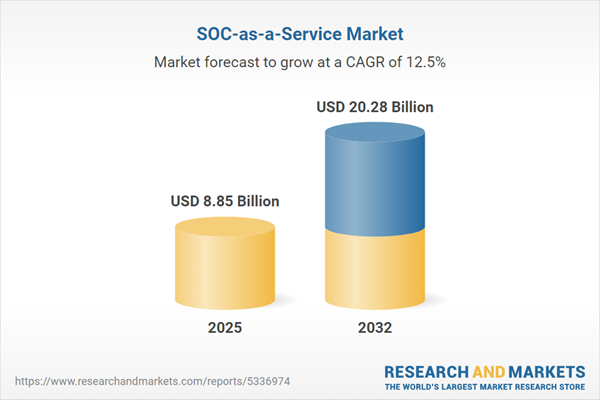Speak directly to the analyst to clarify any post sales queries you may have.
The SOC-as-a-Service market is experiencing robust expansion as organizations face increasing cyber risks and the growing complexity of digital ecosystems. Senior leaders require actionable market intelligence to sustain security resilience and inform strategic technology investments amid this rapidly evolving threat landscape.
Market Snapshot: Growth of the SOC-as-a-Service Market
The SOC-as-a-Service market grew from USD 7.91 billion in 2024 to USD 8.85 billion in 2025. It is projected to maintain strong momentum at a CAGR of 12.48%, reaching USD 20.28 billion by 2032. This growth is driven by the proliferation of digital infrastructure, rising sophistication of attacks, and the shift toward cloud and hybrid operational models that demand advanced security solutions. The market’s continued expansion signals ongoing demand for outsourced security operations, particularly among organizations looking to access specialized skills and automation-led defense without extensive in-house investments.
Scope & Segmentation of the SOC-as-a-Service Market
- Service Types: Incident response and forensics, managed detection and response (MDR), managed security information and event management (SIEM), security orchestration, automation, and response (SOAR) services, threat hunting and analysis, vulnerability and risk management.
- Service Models: Co-managed and fully managed solutions tailored to varying degrees of internal control and resource capacity.
- Applications: Application security, cloud security, endpoint security, and network security, each supporting critical business and infrastructure needs.
- Industry Verticals: Banking, financial services and insurance (including banks, fintech, and insurance companies), energy and utilities, government and public sector, healthcare and life sciences, IT and telecommunications (serving both IT and telecom service providers), retail and e-commerce, and transportation and logistics.
- Organization Sizes: Large enterprises and small & medium enterprises with solutions adapted to complexity and resource availability.
- Geographies: Americas (including North America and Latin America), Europe, Middle East and Africa, and Asia-Pacific, encompassing major economies and emerging digital markets.
Key Takeaways for Senior Decision-Makers
- Externalizing security operations allows organizations to access expertise, threat intelligence, and advanced analytics, aligning resources to strategic tasks and reducing internal bottlenecks.
- AI and machine learning integrations support automated incident response, while adaptive analytics deliver predictive intelligence, shifting teams toward a proactive and strategic security posture.
- Regulatory compliance pressures, such as data localization and breach notification laws across regions, make centralized reporting, audit readiness, and compliance-driven monitoring essential capabilities.
- Hybrid and cloud-focused deployments are now standard, requiring seamless integration across containerized, serverless, and on-premise environments for holistic threat visibility and faster response times.
- Providers are differentiating through partnerships, AI-driven analytics, and service orchestration, enabling organizations to scale protection and enhance detection accuracy as the threat landscape evolves.
Tariff Impact on SOC-as-a-Service Delivery and Economics
Recent adjustments to U.S. tariff schedules have introduced new challenges for service providers, particularly those relying on imported hardware. Increased equipment costs have led vendors to recalibrate pricing structures, affecting procurement cycles and capital allocation. In response, many providers are advancing investment in cloud-native solutions that reduce reliance on physical devices, while international clients are seeking transparent contractual terms and hybrid delivery models to manage economic volatility. Strategic collaborations with domestic manufacturers and open-source initiatives are also helping ease tariff pressures for both providers and clients.
Methodology & Data Sources
This report employs a comprehensive methodology, combining thorough secondary research—drawing on publications, regulatory filings, and technology analyses—with primary insights from interviews and surveys of senior security leaders, operations managers, and technical experts. Data are validated through triangulation and rigorous cross-verification to ensure clarity, consistency, and reliability.
Why This Report Matters
- Enables executive teams to benchmark current security postures and inform investments in strategic automation, intelligence, and compliance-driven solutions.
- Delivers granular analysis across technologies, organizational segments, and regions, supporting informed vendor selection and partnership strategies.
- Provides visibility into regulatory and supply chain factors that impact cost, scalability, and risk mitigation in the SOC-as-a-Service landscape.
Conclusion
Market shifts underscore the need for adaptive, intelligence-led outsourced security operations. Leaders benefit from actionable insights and best practices outlined in this report, enabling robust and future-ready security strategies in a dynamic threat environment.
Additional Product Information:
- Purchase of this report includes 1 year online access with quarterly updates.
- This report can be updated on request. Please contact our Customer Experience team using the Ask a Question widget on our website.
Table of Contents
3. Executive Summary
4. Market Overview
7. Cumulative Impact of Artificial Intelligence 2025
Companies Mentioned
The companies profiled in this SOC-as-a-Service market report include:- Tata Communications Limited
- Thales Group
- Arctic Wolf Networks Inc.
- Binary Defense Systems, Inc.
- CISO Global, Inc.
- ESDS Software Solutions Ltd.
- Expel, Inc.
- Fortinet, Inc.
- Fortra, LLC
- IARM Information Security Pvt.Ltd.
- KPMG LLP
- Netsurion LLC by Lumifi Cyber, Inc.
- Nopal Cyber, LLC
- ProSOC, Inc.
- SafeAeon inc.
- Verizon Communications Inc.
Table Information
| Report Attribute | Details |
|---|---|
| No. of Pages | 183 |
| Published | October 2025 |
| Forecast Period | 2025 - 2032 |
| Estimated Market Value ( USD | $ 8.85 Billion |
| Forecasted Market Value ( USD | $ 20.28 Billion |
| Compound Annual Growth Rate | 12.4% |
| Regions Covered | Global |
| No. of Companies Mentioned | 17 |









